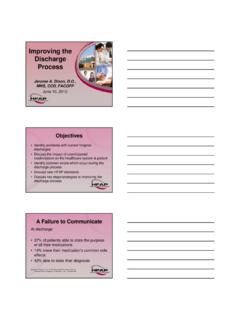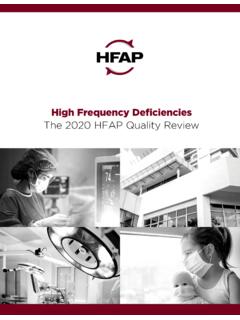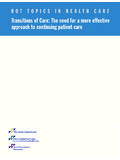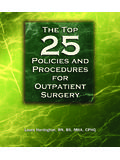Transcription of National Quality Forum (NQF) Endorsed Set of 30 …
1 *The National Quality Forum : Safe Practices for Better Healthcare 2/2013 Update Page 1 of 6 National Quality Forum (NQF) Endorsed Set of 34 Safe Practices* Crosswalk with the 2012-13 HFAP Acute Care Accreditation Hospital Manual NQF Endorsed Set of Safe Practices (released 2009) HFAP-Related Standard(s) 1. Leadership Structures and Systems Leadership structures and systems must be established to ensure that there is organization-wide awareness of patient safety performance gaps, direct accountability of leaders for those gaps, and adequate investment in performance improvement abilities, and that actions are taken to ensure safe care of every patient served. 2. Culture Measurement, Feedback, and Intervention Healthcare organizations must measure their culture, provide feedback to leadership and staff, and undertake interventions that will reduce patient safety risk.
2 3. Teamwork Training and Skill Building Healthcare organizations must establish a proactive, systematic, organization-wide approach to developing team-based care through teamwork training, skill building, and team-led performance improvement interventions that reduce preventable harm to patients. 4. Identification and Mitigation of Risks and Hazards Healthcare organizations must systematically identify and mitigate patient safety risks and hazards with an integrated approach in order to continuously reduce preventable patient harm. 5. Informed Consent Ask each patient or legal surrogate to teach back, his or her own words, key information about the proposed treatments or procedures for which he or she is being asked to provide informed consent.
3 6. Life-Sustaining Treatment Ensure that written documentation of the patient s preferences for life- sustaining treatments is prominently displayed in his or her chart. *The National Quality Forum : Safe Practices for Better Healthcare 2/2013 Update Page 2 of 6 National Quality Forum (NQF) Endorsed Set of 34 Safe Practices* Crosswalk with the 2012-13 HFAP Acute Care Accreditation Hospital Manual 7. Disclosure Following serious unanticipated outcomes, including those that are clearly caused by systems failures, the patient and, as appropriate, the family should receive timely, transparent, and clear communication concerning what is known about the event. 8. Care of the Caregiver Following serious unintentional harm due to systems failures and/or errors that resulted from human performance failures, the involved caregivers (clinical providers, staff, and administrators) should receive timely and systematic care to include: treatment that is just, respect, compassion, supportive medical care, and the opportunity to fully participate in event investigation and risk identification and mitigation activities that will prevent future events.
4 9. Nursing Workforce Implement critical components of a well-designed nursing workforce that mutually reinforce patient safeguards, including the following: A nurse staffing plan with evidence that it is adequately resourced and actively managed and that its effectiveness is regularly evaluated with respect to patient safety. Senior administrative nursing leaders, such as a Chief Nursing Officer, as part of the hospital senior management team. Governance boards and senior administrative leaders that take accountability for reducing patient safety risks related to nurse staffing decisions and the provisions of financial resources for nursing services. Provision of budgetary resources to support nursing staff in the ongoing acquisition and maintenance of professional knowledge and skills.
5 10. Direct Caregivers Ensure that non-nursing direct care staffing levels are adequate, that staff is competent, and that they have had adequate orientation, training, and education to perform their assigned direct care duties. 11. Intensive Care Unit Care All patients in general intensive care units (both adult and pediatric) should be managed by physicians who have specific training and certification in critical care medicine. 12. Patient Care Information Ensure that care information is transmitted and appropriately documented in a timely manner and in a clearly understandable form to patients and to all of *The National Quality Forum : Safe Practices for Better Healthcare 2/2013 Update Page 3 of 6 National Quality Forum (NQF) Endorsed Set of 34 Safe Practices* Crosswalk with the 2012-13 HFAP Acute Care Accreditation Hospital Manual the patient s healthcare providers/professional, within and between care settings, who need that information to provide continued care.
6 13. Order Read-Back and Abbreviations Incorporate within your organization a safe, effective communication strategy, structures, and systems to include the following: For verbal or telephone orders or for telephonic reporting of critical test results, verify the complete order or test result by having the person who is receiving the information record and read-back the complete order or test result. Standardize a list of Do Not Use abbreviations, acronyms, symbols, and dose designations that cannot be used throughout the organizations. 14. Labeling of Diagnostic Studies Implement standardized policies, processes, and systems to ensure accurate labeling of radiographs, laboratory specimens, or other diagnostic studies, so that the right study is labeled for the right patient at the right time.
7 15. Discharge Systems A discharge plan must be prepared for each patient at the time of hospital discharge, and a concise discharge summary must be prepared for and relayed to the clinical caregiver accepting responsibility for post-discharge in care in a timely manner. Organizations must ensure that there are confirmations of receipt of the discharge information by the independent licensed practitioner who will assume the responsibility for care after discharge. 16. Safe Adoption of Computerized Prescriber Order Entry Implement a computerized prescriber order entry (CPOE) system built upon the requisite foundation of re-engineered evidence-based care, an assurance of healthcare organization staff and independent practitioner readiness, and an integrated information technology infrastructure.
8 17. Medication Reconciliation The healthcare organization must develop, reconcile, and communicate an accurate patient medication list throughout the continuum of care. 18. Pharmacist Leadership Structures and Systems Pharmacy leaders should have an active role on the administrative leadership In Revision *The National Quality Forum : Safe Practices for Better Healthcare 2/2013 Update Page 4 of 6 National Quality Forum (NQF) Endorsed Set of 34 Safe Practices* Crosswalk with the 2012-13 HFAP Acute Care Accreditation Hospital Manual team that reflects their authority and accountability for medication management systems performance across the organization. 19. Hand Hygiene Comply with current Centers for Disease Control (CDC) and Prevention Hand Hygiene Guidelines, World Health Organization (WHO) Guidelines on Hand Hygiene and Institute for Healthcare Improvement (IHI) Improving Hand Hygiene Improving Hand Hygiene.
9 20. Influenza Prevention Comply with current Centers for Disease Control and Prevention (CDC) recommendations for influenza vaccinations for healthcare personnel and the annual recommendations of the CDC Advisory Committee on Immunization Practices for individual influenza prevention and control. 21. Central Line-Associated Bloodstream Infection Prevention Take actions to prevent central line-associated bloodstream infection by implementing evidence-based intervention practices. 22. Surgical-Site Infection Prevention Take action to prevent surgical-site infections by implementing evidence-based intervention practices. 23. Care of the Ventilated Patient Take actions to prevent complications associated with ventilated patients: specifically, ventilator-associated pneumonia, venous thromboembolism, peptic ulcer disease, dental complications, and pressure ulcers.
10 24. Multidrug-Resistant Organism Prevention Implement a systematic multi-drug resistant organism (MDRO) eradication program built upon the fundamental elements of infection control, an evidence-based approach, and a re-engineered identification and care process for those patients with or at risk for MDRO infections. Note: This practice applies to, but is not limited to, epidemiologically important organisms such as methicillin-resistant Staphylococcus aureus, vancomycin-resistant enterococci, and Clostridium difficile. Multidrug-resistant gram-negative bacilli, such as Enterobacter species, Klebsiella species, Pseudomonas species, and Escherichia coli, and vancomycin-resistant Staphylococcus aureus, should be evaluated for inclusion on a local system level based on organizational risk assessments.











